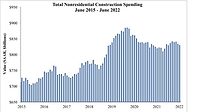Inflation Puts Pressure on Restoration Contractors as Costs Rise

Photo credit:Cemile Bingol / DigitalVision Vectors via Getty Images
Inflation is everywhere and the construction sector, which includes restoration contractors, is among the industries getting the most tightly squeezed.
Construction input prices increased 1.9% in June compared to the previous month, according to an Associated Builders and Contractors analysis of U.S. Bureau of Labor Statistics’ Producer Price Index data released today. Nonresidential construction input prices increased 1.8% for the month.
Construction input prices are up 20.1% from a year ago, while nonresidential construction input prices are 20.3% higher. On a monthly basis, input prices were down in four of 11 subcategories in June, with the largest decline registered in the softwood lumber category (down 24.8%). All three energy subcategories experienced price increases, with natural gas prices rising 24.3% for the month.
“It’s no secret that contractors and their customers have been walloped by massive increases in construction materials prices,” said ABC Chief Economist Anirban Basu. “But more recently, key commodity prices have declined, so it may be possible we have achieved peak inflation.”
That’s not necessarily good news. There are signs a slowing economy is driving down commodity prices. Copper, which is considered an economic bellwether, experienced its sharpest quarterly price decline since 2011 in the second quarter.
The Russian invasion of Ukraine also drove up commodity prices, especially for oil and natural gas. Basu said prices seem to be readjusting and declining as a result. He cautions that the war creates an ongoing risk of sudden spikes in certain commodity prices.
In addition to paying more for what they do get, contractors continue to face inventory shortages. Sixteen percent of construction business owners surveyed by the National Federation of Independent Businesses described current inventory stocks as “too low” in June.
Contractors are seeing their margins shrink. ABC’s Construction Confidence Index readings for sales, profit margins and staffing levels declined in June. The indices for sales and staffing remain above the threshold of 50, indicating expectations of growth over the next six months, while the reading for profit margins fell below the threshold of 50 for the first time since October 2021.
“Several months ago, there was conjecture that contractors were generally too upbeat regarding their collective future,” Basu said. “Increasingly, the data suggest that they were.
“At the time, many contractors reported surging backlog and an ability to pass along hefty cost increases to project owners. For months, contractors expected sales, employment and margins to expand. The most recent ABC survey indicates that, to secure work and to induce project starts, a growing fraction of contractors is having to trim margins.”
Contractors also face ever-rising labor costs. Hourly earnings growth in the Construction sector hit 5% in June, reaching the highest level since 2011, according to the latest Paychex/IHS Markit Small Business Employment Watch. While that was below the overall growth of 5.10%, construction was one of the few sectors to see a month-over-month increase in June.
Owners in the construction industry need to pay more to fill all of their job openings. While the construction industry added 13,000 jobs in June as the number of jobseekers with construction experience plunged to a record low for the month according to an analysis of federal employment data released today by the Associated General Contractors of America. Association officials said the industry would likely have added even more jobs in June had it not been for the shortage of available workers.
“Although nonresidential contractors were able to add employees in June, the industry needs more as demand for projects is outpacing the supply of workers,” said Ken Simonson, the association’s chief economist. “With industry unemployment at a record low for June and openings at an all-time high for May, it is clear contractors can’t fill all the positions they would like to.”
There were 466,000 construction-industry job openings at the end of May, a jump of 130,000 or 39 percent from a year earlier and the largest May total since that series began in 2000, Simonson said.Looking for a reprint of this article?
From high-res PDFs to custom plaques, order your copy today!






